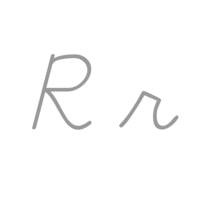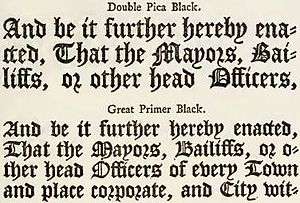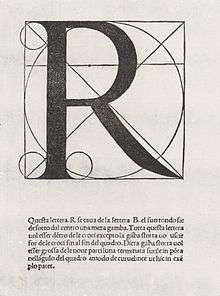R
R or r is the 18th letter of the modern English alphabet and the ISO basic Latin alphabet. Its name in English is ar (pronounced /ˈɑːr/), plural ars,[1] or in Ireland or /ˈɔːr/.[2]
| R | |
|---|---|
| R r | |
| (See below) | |
 | |
| Usage | |
| Writing system | Latin script |
| Type | Alphabetic and Logographic |
| Language of origin | Latin language |
| Phonetic usage | [r] [ɾ] [ɹ] [ɻ] [ʀ] [ʁ] (Table) (English variations) /ɑːr/ |
| Unicode value | U+0052, U+0072 |
| Alphabetical position | 18 |
| History | |
| Development | |
| Time period | ~50 to present |
| Descendants | • ℟ • ℞ • ® • Ɍ • ᚱ • 𐍂 • Ꭱ |
| Sisters | Р ר ر ܪ ࠓ 𐎗 𐡓 ረ Ռ ռ Ր ր ર र |
| Variations | (See below) |
| Other | |
| Other letters commonly used with | r(x), rh |
|
History
| Egyptian hieroglyph tp (D1) |
Phoenician Resh |
Archaic Greek/Old Italic Rho |
Roman square capital R |
15th century Florentine inscriptional capital |
blackletter (Fraktur) | German kurrent | modern cursive (D'Nealian 1978) | ||
 |
 |
 |
 |
Antiquity
The original Semitic letter may have been inspired by an Egyptian hieroglyph for tp, "head". It was used for /r/ by Semites because in their language, the word for "head" was rêš (also the name of the letter). It developed into Greek 'Ρ' ῥῶ (rhô) and Latin R.
The descending diagonal stroke develops as a graphic variant in some Western Greek alphabets (writing rho as ![]()
Cursive


The minuscule (lowercase) form (r) developed through several variations on the capital form. Along with Latin minuscule writing in general, it developed ultimately from Roman cursive via the uncial script of Late Antiquity into the Carolingian minuscule of the 9th century.
In handwriting, it was common not to close the bottom of the loop but continue into the leg, saving an extra pen stroke. The loop-leg stroke shortened into the simple arc used in the Carolingian minuscule and until today.
A calligraphic minuscule r, known as r rotunda (ꝛ), was used in the sequence or, bending the shape of the r to accommodate the bulge of the o (as in oꝛ as opposed to or). Later, the same variant was also used where r followed other lower case letters with a rounded loop towards the right (such as b, h, p) and to write the geminate rr (as ꝛꝛ). Use of r rotunda was mostly tied to blackletter typefaces, and the glyph fell out of use along with blackletter fonts in English language contexts mostly by the 18th century.
Insular script used a minuscule which retained two downward strokes, but which did not close the loop ("Insular r", ꞃ); this variant survives in the Gaelic type popular in Ireland until the mid-20th century (but now mostly limited to decorative purposes).
Name
The name of the letter in Latin was er (/ɛr/), following the pattern of other letters representing continuants, such as F, L, M, N and S. This name is preserved in French and many other languages. In Middle English, the name of the letter changed from /ɛr/ to /ar/, following a pattern exhibited in many other words such as farm (compare French ferme) and star (compare German Stern).
In Hiberno-English the letter is called /ɒr/ or /ɔːr/, somewhat similar to oar, ore, orr.[3][4][5]
The letter R is sometimes referred to as the littera canīna (literally 'canine letter', often rendered in English as the dog's letter). This Latin term referred to the Latin R was trilled to sound like a growling dog, a spoken style referred to as vōx canīna ('dog voice'). A good example of a trilled R is in the Spanish word for dog, perro.[6]
In William Shakespeare's Romeo and Juliet, such a reference is made by Juliet's nurse in Act 2, scene 4, when she calls the letter R "the dog's name". The reference is also found in Ben Jonson's English Grammar.[7]
Pronunciation and use
| Most common pronunciation: /r/
Languages in italics do not use the roman alphabet; the table refers to romanizations | ||||
|---|---|---|---|---|
| Language | Dialect(s) | Pronunciation (IPA) | Environment | Notes |
| Albanian | /ɾ/ | |||
| Arabic | Most dialects | /r/ | ||
| North Mesopotamian, Judeo-Iraqi | /ʀ/ | |||
| Catalan | /r/ | Word-initially | ||
| /ɾ/ | Usually | |||
| Danish | /ʀ/ | |||
| /r/ | Archaic | |||
| Dutch | Most dialects | /ɾ/ | ||
| Brabantish, Limburgish | /ʀ/ | |||
| English | Non-rhotic | /ɹ/ | Before vowels | |
| silent | After vowels | |||
| Rhotic | /ɻ/ | Before vowels | ||
| ʵ | After vowels | |||
| Faroese | /ɹ/ | |||
| French | /ʁ/ | |||
| Galician | /ɾ/ | |||
| German | Standard | /ʀ/ | Before vowels | |
| /ɐ̯/ | After vowels | |||
| Gutnish | /ɻ/ | |||
| Haitian | /ɣ/ | |||
| Hebrew | /ʁ/ | |||
| /r/ | Archaic | |||
| Hopi | /ʐ/ | |||
| Irish | /ɾ/ | |||
| /ɻʲ/ | After i; before e, i | |||
| Italian | /ɾ/ | |||
| Japanese | Standard | /ɾ/ | ||
| Leonese | /ɾ/ | |||
| Mandarin | Standard | /ʐ/ | ||
| Manx | /ɹ/ | |||
| silent | ||||
| Māori | /ɾ/ | |||
| Norwegian | Most dialects | /r/ | ||
| Western and Southern dialects | /ʁ/ | |||
| Tromsø | /ʐ/ | |||
| Portuguese | /ʁ/ | |||
| /ɾ/ | Archaic | |||
| Scottish Gaelic | /ɾ/ | Usually | ||
| /ɾʲ/ | After i; before e, i | |||
| Sicilian | /ɹ/ | |||
| Spanish | Some dialects | /l/ | After a vowel | |
| Most dialects | /r/ | Word-initially | ||
| All dialects | /ɾ/ | Usually | ||
| Puerto Rican | /ʁ/ | Word-initially | ||
| Swedish | Most dialects | /ɾ/ | ||
| Southern dialects | /ʀ/ | |||
| Turkish | /ɾ/ | |||
| Venetian | Most dialects | /ɾ/ | ||
| Venice | /ʀ/ | |||
English
The letter ⟨r⟩ is the eighth most common letter in English and the fourth-most common consonant (after ⟨t⟩, ⟨n⟩, and ⟨s⟩).[8]
The letter ⟨r⟩ is used to form the ending "-re", which is used in certain words such as centre in some varieties of English spelling, such as British English. Canadian English also uses the "-re" ending, unlike American English, where the ending is usually replaced by "-er" (center). This does not affect pronunciation.
Other languages
⟨r⟩ represents a rhotic consonant in many languages, as shown in the table below.
| Alveolar trill [r] | Listen | some dialects of British English or in emphatic speech, standard Dutch, Finnish, Galician, German in some dialects, Hungarian, Icelandic, Indonesian, Italian, Czech, Javanese, Lithuanian, Latvian, Latin, Norwegian mostly in the northwest, Polish, Portuguese (traditional form), Romanian, Russian, Scots, Slovak, Swedish, Sundanese, Welsh; also Catalan, Spanish and Albanian ⟨rr⟩ |
| Alveolar approximant [ɹ] | Listen | English (most varieties), Dutch in some Dutch dialects (in specific positions of words), Faroese, Sicilian |
| Alveolar flap / Alveolar tap [ɾ] | Listen | Portuguese, Catalan, Spanish and Albanian ⟨r⟩, Turkish, Dutch, Italian, Venetian, Galician, Leonese, Norwegian, Irish, Māori |
| Voiced retroflex fricative [ʐ] | Listen | Norwegian around Tromsø; Spanish used as an allophone of /r/ in some South American accents; Hopi used before vowels, as in raana, "toad", from Spanish rana; Hanyu Pinyin transliteration of Standard Chinese. |
| Retroflex approximant [ɻ] | Listen | some English dialects (in the United States, South West England, and Dublin), Gutnish |
| Retroflex flap [ɽ] | Listen | Norwegian when followed by <d>, sometimes in Scottish English |
| Uvular trill [ʀ] | Listen | German stage standard; some Dutch dialects (in Brabant and Limburg, and some city dialects in The Netherlands), Swedish in Southern Sweden, Norwegian in western and southern parts, Venetian only in Venice area. |
| Voiced uvular fricative [ʁ] | Listen | North Mesopotamian Arabic, Judeo-Iraqi Arabic, German, Danish, French, standard European Portuguese ⟨rr⟩, standard Brazilian Portuguese ⟨rr⟩, Puerto Rican Spanish ⟨rr⟩ and 'r-' in western parts, Norwegian in western and southern parts. |
Other languages may use the letter ⟨r⟩ in their alphabets (or Latin transliterations schemes) to represent rhotic consonants different from the alveolar trill. In Haitian Creole, it represents a sound so weak that it is often written interchangeably with ⟨w⟩, e.g. 'Kweyol' for 'Kreyol'.
Brazilian Portuguese has a great number of allophones of /ʁ/ such as [χ], [h], [ɦ], [x], [ɣ], [ɹ] and [r], the latter three ones can be used only in certain contexts ([ɣ] and [r] as ⟨rr⟩; [ɹ] in the syllable coda, as an allophone of /ɾ/ according to the European Portuguese norm and /ʁ/ according to the Brazilian Portuguese norm). Usually at least two of them are present in a single dialect, such as Rio de Janeiro's [ʁ], [χ], [ɦ] and, for a few speakers, [ɣ].
Other systems
The International Phonetic Alphabet uses several variations of the letter to represent the different rhotic consonants; ⟨r⟩ represents the alveolar trill.
Related characters
Descendants and related characters in the Latin alphabet
- R with diacritics: Ŕ ŕ Ɍ ɍ Ř ř Ŗ ŗ Ṙ ṙ Ȑ ȑ Ȓ ȓ Ṛ ṛ Ṝ ṝ Ṟ ṟ Ꞧ ꞧ Ɽ ɽ R̃ r̃ ᵲ[9] ꭨ[10] ᵳ[9] ᶉ[11]
- International Phonetic Alphabet-specific symbols related to R: ɹ ɺ ɾ ɻ ɽ ʀ ʁ ʶ ˞ ʴ
- Obsolete and nonstandard symbols in the International Phonetic Alphabet: ɼ ɿ
- Uralic Phonetic Alphabet-specific symbols related to R:[12]
- U+1D19 ᴙ LATIN LETTER SMALL CAPITAL REVERSED R
- U+1D1A ᴚ LATIN LETTER SMALL CAPITAL TURNED R
- U+1D3F ᴿ MODIFIER LETTER CAPITAL R
- U+1D63 ᵣ LATIN SUBSCRIPT SMALL LETTER R
- Teuthonista phonetic transcription-specific symbols related to R:[13]
- U+AB45 ꭅ LATIN SMALL LETTER STIRRUP R
- U+AB46 ꭆ LATIN LETTER SMALL CAPITAL R WITH RIGHT LEG
- U+AB47 ꭇ LATIN SMALL LETTER R WITHOUT HANDLE
- U+AB48 ꭈ LATIN SMALL LETTER DOUBLE R
- U+AB49 ꭉ LATIN SMALL LETTER R WITH CROSSED-TAIL
- U+AB4A ꭊ LATIN SMALL LETTER DOUBLE R WITH CROSSED-TAIL
- U+AB4B ꭋ LATIN SMALL LETTER SCRIPT R
- U+AB4C ꭌ LATIN SMALL LETTER SCRIPT R WITH RING
- ⱹ : Turned r with tail is used in the Swedish Dialect Alphabet[14]
- Other variations of R used for phonetic transcription: ʳ ʵ
Calligraphic variants in the Latin alphabet
- Ꝛ ꝛ : R rotunda
- Ꞃ ꞃ : "Insular" R (Gaelic type)
Ancestors and siblings in other alphabets
Abbreviations, signs and symbols
- ℟: symbol for "response" in liturgy
- ℞ : Medical prescription Rx
- ₽ : Ruble symbol
- ® : Registered trademark symbol
Physics
| Notation | Quantity | Unit |
|---|---|---|
| R | electrical resistance | ohm (Ω) |
| Ricci tensor | unitless | |
| radiancy | ||
| gas constant | joule per mole-kelvin (J/(mol·K)) | |
| r | radius vector (position) | meter (m) |
| r | radius of rotation or distance between two things such as the masses in Newton's law of universal gravitation | meter (m) |
Chemistry
- In a chemical formula, used to indicate a substituent, also known as an "R group". For example, "Na(OR)".
- In the preferred IUPAC name for a chemical, used to indicate a specific enantiomer. For example, "(R)-2-(4-Chloro-2-methylphenoxy)propanoic acid" is one of the enantiomers of mecoprop.
Encoding
| Preview | R | r | ||
|---|---|---|---|---|
| Unicode name | LATIN CAPITAL LETTER R | LATIN SMALL LETTER R | ||
| Encodings | decimal | hex | decimal | hex |
| Unicode | 82 | U+0052 | 114 | U+0072 |
| UTF-8 | 82 | 52 | 114 | 72 |
| Numeric character reference | R | R | r | r |
| EBCDIC family | 217 | D9 | 153 | 99 |
| ASCII 1 | 82 | 52 | 114 | 72 |
- 1 Also for encodings based on ASCII, including the DOS, Windows, ISO-8859 and Macintosh families of encodings.
Other representations
| NATO phonetic | Morse code |
| Romeo |
 |
|
 |
 |
| Signal flag | Flag semaphore | American manual alphabet (ASL fingerspelling) | Braille dots-1235 Unified English Braille |
See also
References
- "R", Oxford English Dictionary 2nd edition (1989); "ar", op. cit
- "Analysis of selected contemporary Irish dialects" (PDF). Digilib.k.utb.cz. Retrieved 7 November 2017.
- Hogarty, Steve (November 11, 2013). "Losing My Voice - This Happened to Me". Medium.
- "Mind your 'P's and 'Q's – ore you'll get into trouble!". December 19, 2018.
- "A Word A Day: Dog's letter". Wordsmith.org. Retrieved 2012-01-17.
- Shakespeare, William; Horace Howard Furness; Frederick Williams (1913). Romeo and Juliet. Lippincott. p. 189.
- "Frequency Table". Math.cornell.edu. Retrieved 7 November 2017.
- Constable, Peter (2003-09-30). "L2/03-174R2: Proposal to Encode Phonetic Symbols with Middle Tilde in the UCS" (PDF). Unicode.org.
- Everson, Michael (2019-05-05). "L2/19-075R: Proposal to add six phonetic characters for Scots to the UCS" (PDF).
- Constable, Peter (2004-04-19). "L2/04-132 Proposal to add additional phonetic characters to the UCS" (PDF). Unicode.org.
- Everson, Michael; et al. (2002-03-20). "L2/02-141: Uralic Phonetic Alphabet characters for the UCS" (PDF). Unicode.org.
- Everson, Michael; Dicklberger, Alois; Pentzlin, Karl; Wandl-Vogt, Eveline (2011-06-02). "L2/11-202: Revised proposal to encode "Teuthonista" phonetic characters in the UCS" (PDF). Unicode.org.
- Lemonen, Therese; Ruppel, Klaas; Kolehmainen, Erkki I.; Sandström, Caroline (2006-01-26). "L2/06-036: Proposal to encode characters for Ordbok över Finlands svenska folkmål in the UCS" (PDF). Unicode.org.
